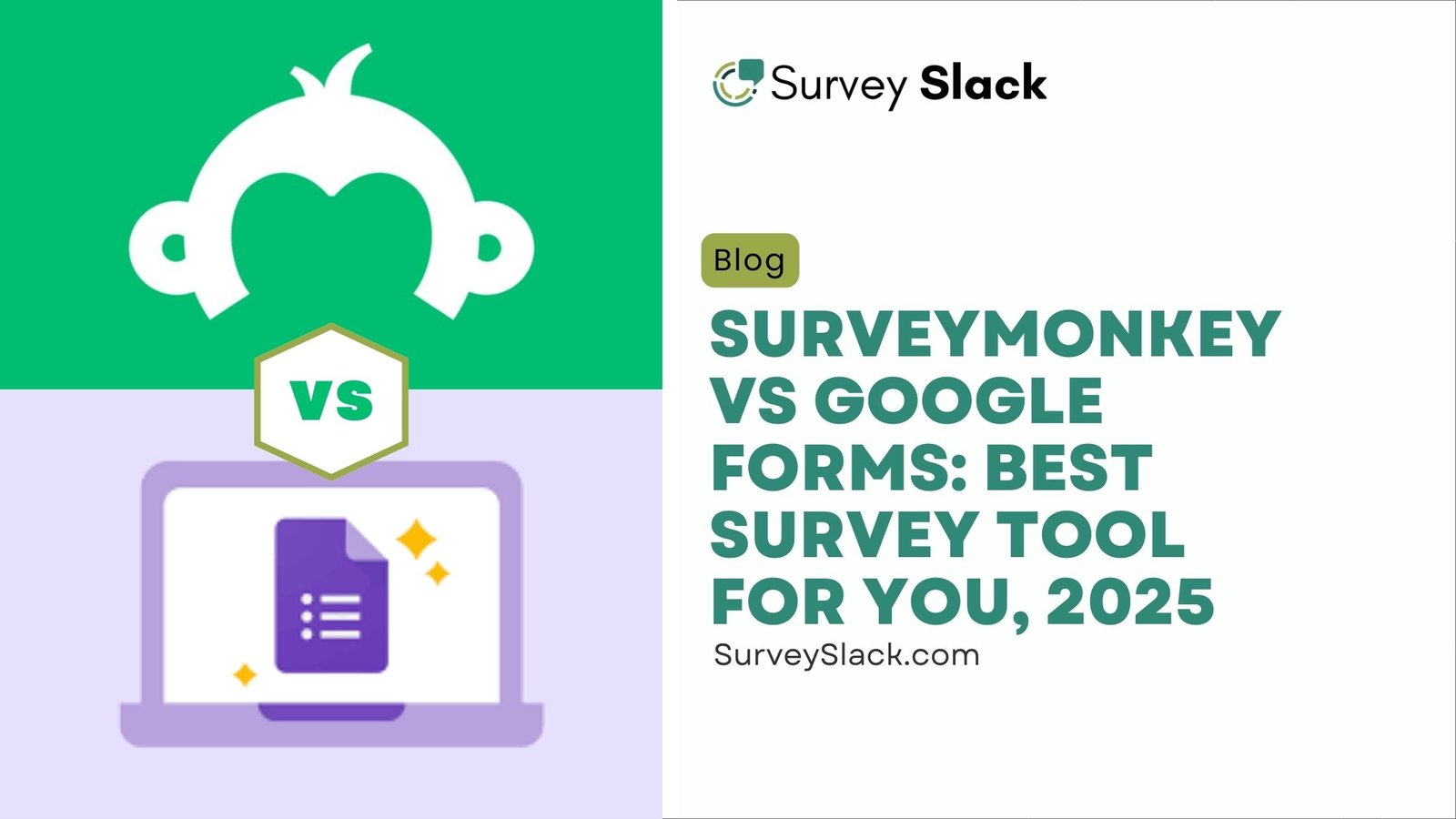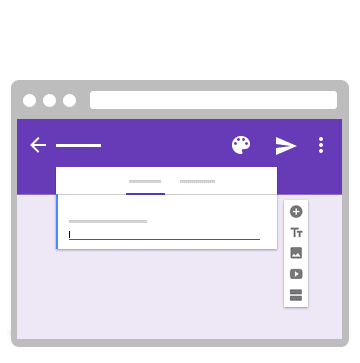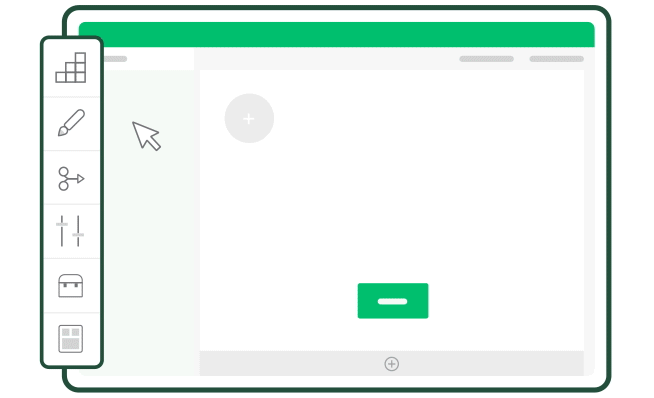SurveyMonkey vs Google Forms: Which Survey Tool is Best For Me? [2025]
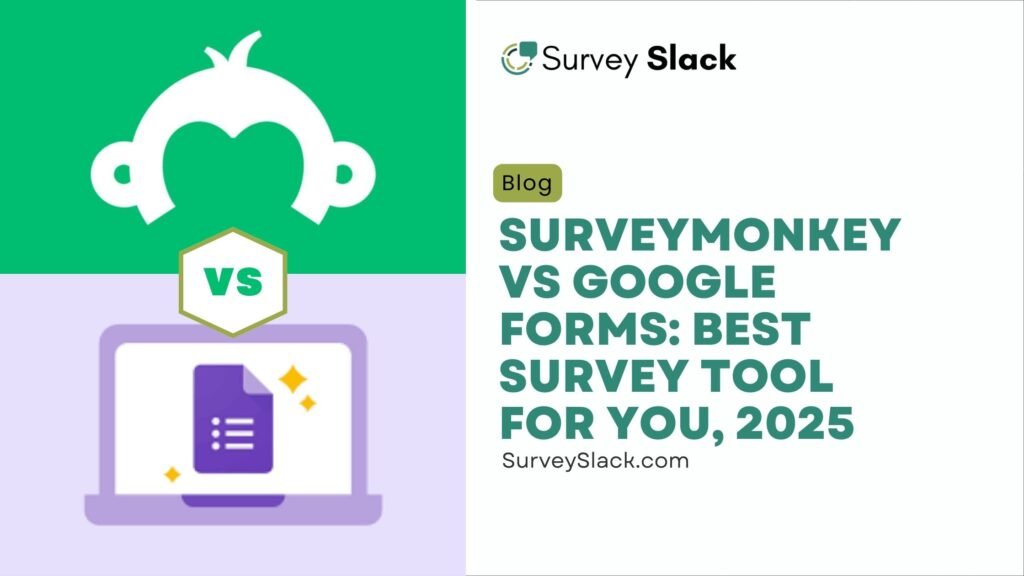
When deciding between SurveyMonkey vs Google Forms in 2025, it’s easy to feel stuck—both are top choices for creating a survey.
Google Forms is a free online form builder app that offers all the features you need to create a simple poll or dynamic survey.
SurveyMonkey, on the other hand, drives over 125 million visitors every month, with 70+ million of those being unique visitors. With such a wide user base, how do you know which is the better option for your needs?
Whether you’re using Survey Monkey or Google Forms to create a survey, both are popular survey software options. With features like customizable survey templates and powerful feedback collection tools, they cater to a variety of needs
With so many choices, it can be tough to know whether SurveyMonkey or Google Forms is the better fit for your survey needs—whether you’re gathering customer feedback or creating an employee experience survey.
You don’t want to waste time testing each platform to figure out the difference between Google Forms versus SurveyMonkey. The stakes are high—whether it’s about ease of use or data collection, you need the right tool now.
In this comparison, we’ll delve into the key aspects of Google Forms vs Survey Monkey, helping you make an informed decision tailored to your specific requirements.
Let’s simplify the choice and help you pick the best online survey tool for 2025.
In this Post, We’ll Cover:
- What is Google Forms?
- What is SurveyMonkey?
- SurveyMonkey vs Google Forms: According to G2
- Taking this into account…
- SurveyMonkey vs Google Forms: Features
- SurveyMonkey vs Google Forms: Design tools
- SurveyMonkey vs Google Forms: Scalability
- SurveyMonkey vs Google Forms: Integration Capabilities
- SurveyMonkey vs Google Forms: Mobile Compatibility
- SurveyMonkey vs Google Forms: Data Security
- SurveyMonkey vs Google Forms: Customer Support & Training
- SurveyMonkey vs Google Forms: Customer Reviews
- SurveyMonkey vs Google Forms: Pricing
- SurveyMonkey vs Google Forms: Which One is Best for Your Needs?
Here we go!
TL;DR
- Google Forms is a free and user-friendly tool, perfect for individuals, educators, and small businesses.
- It integrates seamlessly with Google Workspace, making data collection and sharing straightforward.
- Best suited for simple surveys, it offers basic customization options.
- SurveyMonkey, on the other hand, provides a robust set of features such as advanced customization, diverse question types, and detailed data analysis tools.
- It caters to large enterprises and researchers requiring comprehensive survey capabilities.
- SurveyMonkey’s premium plans start at $39/month, making it a higher-cost option compared to Google Forms.
- The choice between the two depends on the complexity of your survey needs and budget constraints.
What is Google Forms?
Google Forms is a free tool from Google, launched in 2008. It’s part of the Google Workspace suite and is designed for creating surveys, quizzes, and feedback forms.
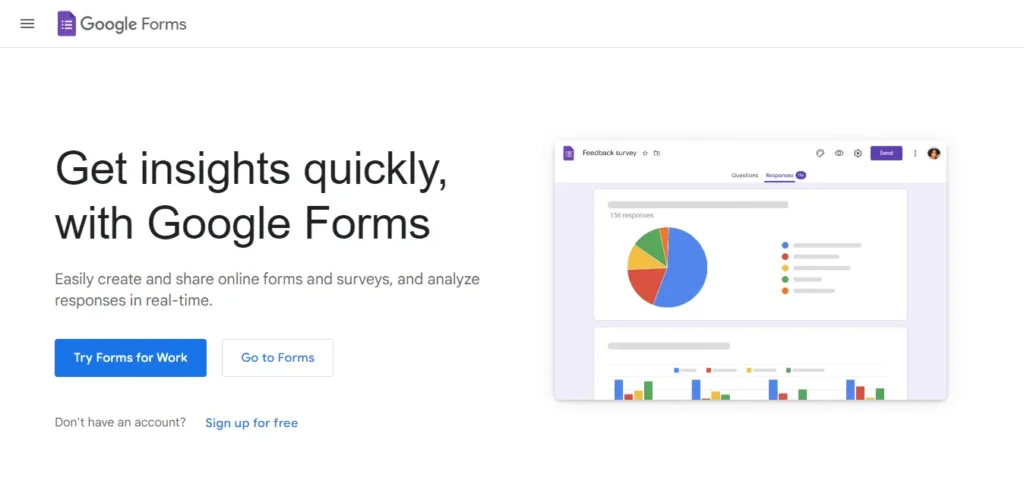
- Free to use with a Google account
- Seamlessly integrates with Google Drive
- Simple, user-friendly interface
Google Forms is an online form builder that lets you create surveys and polls effortlessly. It’s perfect for individuals, educators, and businesses.
Key features include:
- Customizable forms with different question types (multiple-choice, text input, etc.)
- Instant feedback collection via links, email, or embedded forms
- Real-time data storage in Google Sheets for easy analysis
- No technical skills are required to create surveys
It’s straightforward, intuitive, and completely free—making it a popular choice for simple surveys and feedback collection.
What is SurveyMonkey?
SurveyMonkey is a leading online survey tool founded in 1999. With over 25 years of experience, it has become one of the most popular survey creation tools worldwide. It caters to businesses, educators, researchers, and anyone who needs to collect feedback.
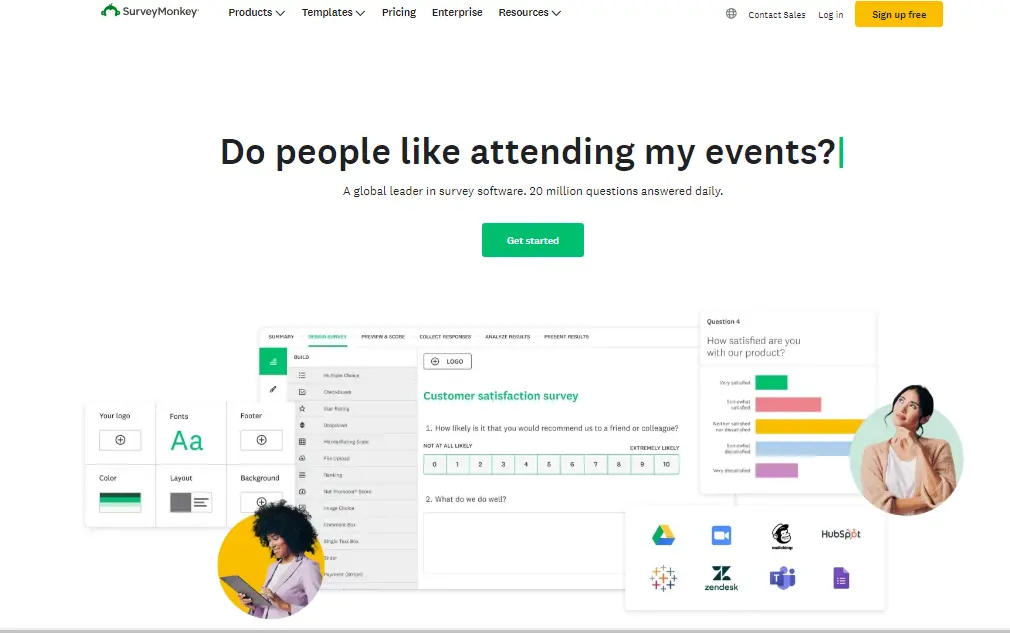
SurveyMonkey’s robust platform offers a range of advanced features, including survey templates, analytics tools, and integration options, making it a top choice for those who need more flexibility and customization in their surveys.
- Founded in 1999
- Over 25 million active users
- Trusted by businesses and organizations globally
SurveyMonkey is a comprehensive best survey software designed to help users create, distribute, and analyze surveys with ease. It offers a variety of advanced features for more detailed feedback collection.
Key features include:
- Customizable survey templates for quick setup
- Advanced analytics to analyze survey data
- Survey logic (skip logic, branching) for tailored experiences
- Integrations with popular tools (CRM, email marketing)
- AI-powered tools for generating survey questions
With both free and paid plans, SurveyMonkey is ideal for those who need powerful tools for market research, customer feedback, and employee surveys.
Suggested Read:
- SurveyMonkey vs Qualtrics: Which Survey Tool is Best For Me?
- Typeform vs. SurveyMonkey: Which Is Better for You? [2025]
- SurveyMonkey vs Jotform: Which Survey Tool Should I Use?
SurveyMonkey vs Google Forms: According to G2, Software Advice
You know those two giants, Google Survey vs Surveymonkey? They’re like the Coke and Pepsi of online surveys – both popular, both with their unique fizz.
But which one’s the real winner? Let’s dive in and see which platform reigns supreme, based on what real users are saying.
SurveyMonkey User Ratings:
- G2: SurveyMonkey holds a rating of 4.4 out of 5 stars, based on over 22,908 reviews. Users appreciate its advanced analytics and customizable survey templates.
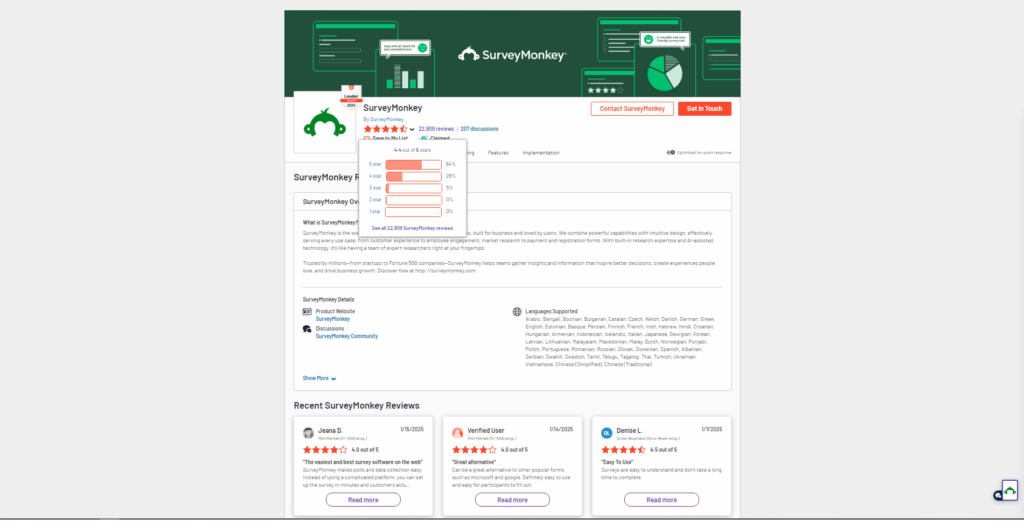
Pros:
- Advanced Analytics: Provides in-depth data analysis tools.
- Customizable Templates: Offers a variety of templates to suit different survey needs.
- Integration Capabilities: Seamlessly integrates with various platforms like Salesforce and Mailchimp.
Cons:
- Pricing: Some users find the pricing plans to be on the higher side.
- Learning Curve: New users might find the interface a bit complex initially.
Google Forms User Ratings:
- Software Advice: Google Forms has a rating of 4.7 out of 5 stars, based on over 10,965 reviews. Users commend its ease of use and seamless integration with Google Workspace.

Pros:
- Cost-Effective: Completely free to use.
- User-Friendly: Simple interface that’s easy to navigate.
- Integration: Seamlessly integrates with Google Workspace tools like Sheets and Docs.
Cons:
- Limited Features: Lacks some advanced features found in other survey tools.
- Customization: Offers fewer customization options compared to competitors.
Market Presence: Who’s Leading?
- If you're seeking advanced features for business use, SurveyMonkey emerges as the top choice due to its in-depth analytics, customizable templates, and robust integration capabilities.
- If you require a straightforward, user-friendly tool that is free and integrates seamlessly with other Google services, Google Forms is an excellent option.
Disclaimer: This is a simplified comparison based on the provided information. Real-world performance and user experience may vary.
Taking this into account…
What if we told you there’s a platform that blends the simplicity of SurveyMonkey with some of the advanced features of Jotform—and it’s affordable for small businesses?
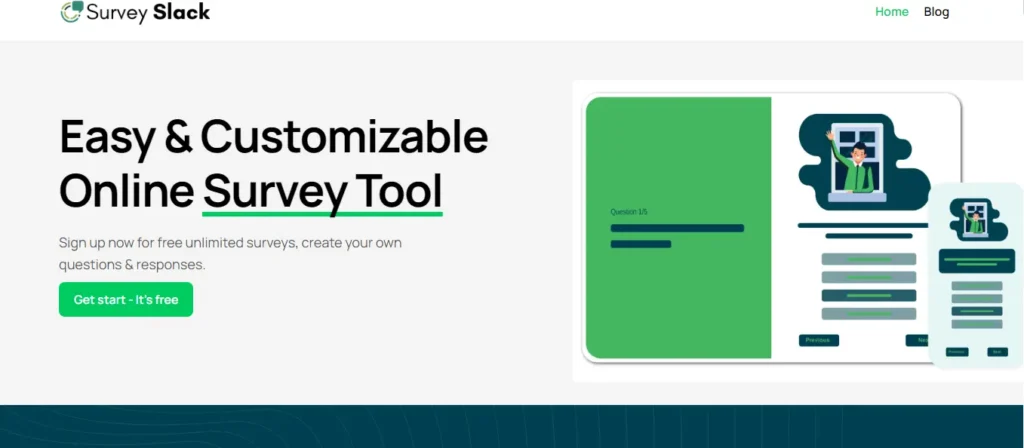
Enter SurveySlack an online survey maker & best form builder in the market. Whether you’re creating surveys with various question types, including Likert scale examples, making it ideal for gathering detailed respondent opinions on a scale of agreement or frequency for your team, customers, or students, SurveySlack offers:
- A user-friendly interface without sacrificing powerful features.
- An AI Survey Questions Generator that works smoothly and freely.
- Pre-designed survey templates for gathering feedback from customer feedback survey templates to employee feedback survey templates, and exit interview survey.
- Affordable pricing that works for small businesses and individuals.
- More.
Ready to take your surveys to the next level? Explore SurveySlack Premium now and enjoy an exclusive 3-month FREE coupon! Experience all the powerful features—like automation, data insights, and user-friendly survey creation tools—completely on us.
SurveyMonkey vs Google Forms: Features
Choosing between Google Forms Survey vs SurveyMonkey can feel like deciding between pizza toppings—both are great, but one might suit your cravings better. Let’s dive into their standout features to help you pick the right fit and see which one checks all your boxes.
SurveyMonkey Features
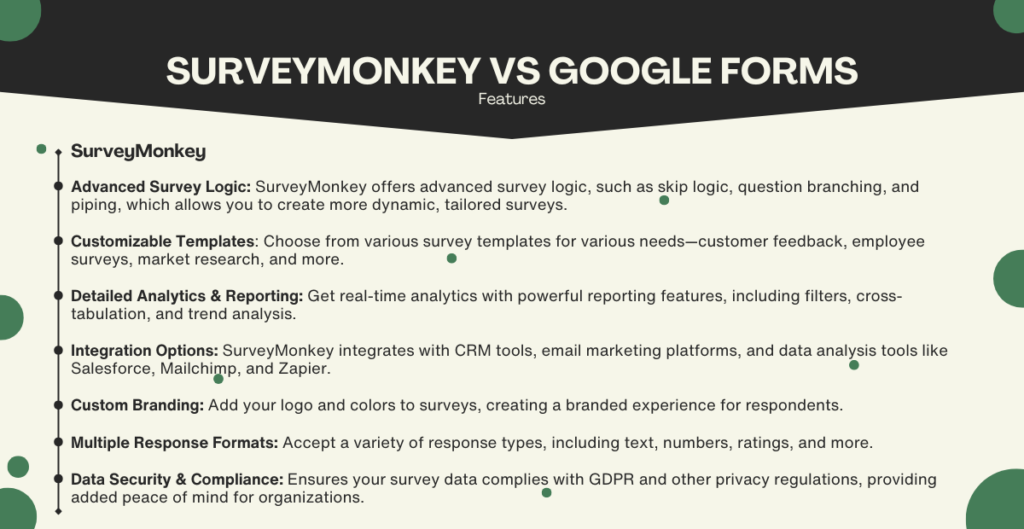
- Advanced Survey Logic: SurveyMonkey offers advanced survey logic, such as skip logic, question branching, and piping, which allows you to create more dynamic, tailored surveys.
- Customizable Templates: Choose from various survey templates for various needs—customer feedback, employee surveys, market research, and more.
- Detailed Analytics & Reporting: Get real-time analytics with powerful reporting features, including filters, cross-tabulation, and trend analysis.
- Integration Options: SurveyMonkey integrates with CRM tools, email marketing platforms, and data analysis tools like Salesforce, Mailchimp, and Zapier.
- Custom Branding: Add your logo and colors to surveys, creating a branded experience for respondents.
- Multiple Response Formats: Accept a variety of response types, including text, numbers, ratings, and more.
- Data Security & Compliance: Ensures your survey data complies with GDPR and other privacy regulations, providing added peace of mind for organizations.
Google Forms Features
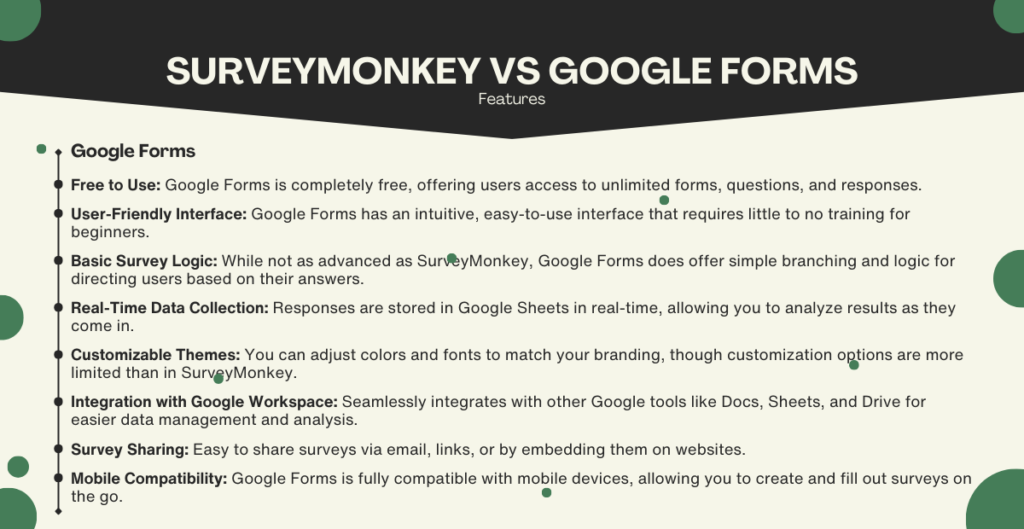
- Free to Use: Google Forms is completely free, offering users access to unlimited forms, questions, and responses.
- User-Friendly Interface: Google Forms has an intuitive, easy-to-use interface that requires little to no training for beginners.
- Basic Survey Logic: While not as advanced as SurveyMonkey, Google Forms does offer simple branching and logic for directing users based on their answers.
- Real-Time Data Collection: Responses are stored in Google Sheets in real-time, allowing you to analyze results as they come in.
- Customizable Themes: You can adjust colors and fonts to match your branding, though customization options are more limited than in SurveyMonkey.
- Integration with Google Workspace: Seamlessly integrates with other Google tools like Docs, Sheets, and Drive for easier data management and analysis.
- Survey Sharing: Easy to share surveys via email, links, or by embedding them on websites.
- Mobile Compatibility: Google Forms is fully compatible with mobile devices, allowing you to create and fill out surveys on the go.
Difference Between SurveyMonkey and Google Forms, features:
| Feature | SurveyMonkey | Google Forms |
| Survey Logic | Advanced (skip logic, branching) | Basic (simple branching) |
| Customization | High (branding, design, templates) | Low (basic theme adjustments) |
| Analytics | Detailed reporting and analytics | Basic data collection in Google Sheets |
| Integration | Wide range of integrations (Salesforce, Zapier) | Limited to Google Workspace tools |
| Pricing | Free plan available; paid plans needed for advanced features | Completely free |
| Ease of Use | User-friendly but with a steeper learning curve | Extremely simple, intuitive interface |
Which Survey Tool Takes the W or L?
- Winner: SurveyMonkey, scoring a 9 out of 10, stands out with its advanced features like custom survey logic, detailed analytics, and powerful integrations. It’s the go-to option for businesses and organizations looking for a professional, fully customizable survey experience.
- Google Forms follows with a 7 out of 10, offering a simple, cost-effective solution with its easy-to-use interface and seamless integration with Google Workspace. However, its lack of advanced features and customization limits its appeal for more complex surveys.
Disclaimer: This is a simplified comparison based on the provided information. Real-world performance and user experience may vary.
SurveyMonkey vs Google Forms: Design tools
The design tools in both SurveyMonkey and Google Forms play a crucial role in making your surveys visually appealing and user-friendly. Here’s how they compare:
SurveyMonkey Design Tools
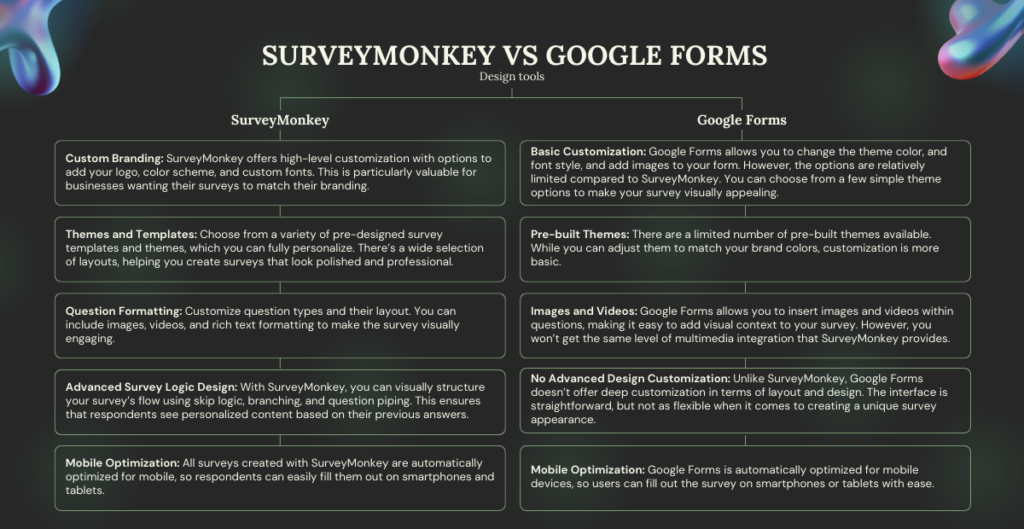
- Custom Branding: SurveyMonkey offers high-level customization with options to add your logo, color scheme, and custom fonts. This is particularly valuable for businesses wanting their surveys to match their branding.
- Themes and Templates: Choose from a variety of pre-designed survey templates and themes, which you can fully personalize. There’s a wide selection of layouts, helping you create surveys that look polished and professional.
- Question Formatting: Customize question types and their layout. You can include images, videos, and rich text formatting to make the survey visually engaging.
- Advanced Survey Logic Design: With SurveyMonkey, you can visually structure your survey’s flow using skip logic, branching, and question piping. This ensures that respondents see personalized content based on their previous answers.
- Mobile Optimization: All surveys created with SurveyMonkey are automatically optimized for mobile, so respondents can easily fill them out on smartphones and tablets.
Google Forms Design Tools
- Basic Customization: Google Forms allows you to change the theme color, and font style, and add images to your form. However, the options are relatively limited compared to SurveyMonkey. You can choose from a few simple theme options to make your survey visually appealing.
- Pre-built Themes: There are a limited number of pre-built themes available. While you can adjust them to match your brand colors, customization is more basic.
- Images and Videos: Google Forms allows you to insert images and videos within questions, making it easy to add visual context to your survey. However, you won’t get the same level of multimedia integration that SurveyMonkey provides.
- No Advanced Design Customization: Unlike SurveyMonkey, Google Forms doesn’t offer deep customization in terms of layout and design. The interface is straightforward, but not as flexible when it comes to creating a unique survey appearance.
- Mobile Optimization: Google Forms is automatically optimized for mobile devices, so users can fill out the survey on smartphones or tablets with ease.
Difference Between SurveyMonkey and Google Forms, Design Tools:
| Feature | SurveyMonkey | Google Forms |
| Customization | High (custom logos, fonts, colors) | Low (basic color changes and fonts) |
| Pre-built Templates/Themes | Extensive, customizable | Limited options, mostly basic |
| Question Formatting | Advanced (images, videos, custom formats) | Basic (images and videos only in questions) |
| Survey Logic Design | Advanced (skip logic, branching) | Basic (simple branching available) |
| Mobile Optimization | Automatically mobile-optimized | Automatically mobile-optimized |
Which Survey Tool Takes the W or L?
- Winner: SurveyMonkey, scoring a 9 out of 10, takes the lead with its extensive design tools, offering advanced customization options, including custom logos, fonts, colors, and layout flexibility. It also provides sophisticated survey logic to create highly personalized surveys that align with your brand.
- Google Forms follows with a 6 out of 10, offering basic design customization with simple themes, colors, and the ability to add images and videos. However, it lacks the advanced design and layout flexibility found in SurveyMonkey, making it better suited for quick, simple surveys rather than professional, branded ones.
Disclaimer: This is a simplified comparison based on the provided information. Real-world performance and user experience may vary.
SurveyMonkey vs Google Forms: Scalability
Scalability is an essential factor when choosing a survey tool, especially for growing businesses or large organizations. Here’s how SurveyMonkey and Google Forms measure up in terms of scalability:
SurveyMonkey Scalability
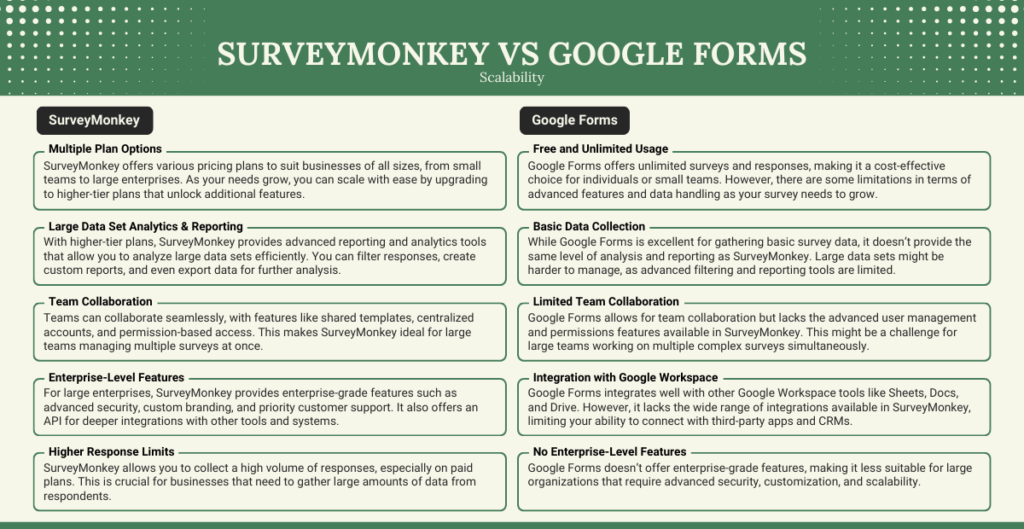
- Multiple Plan Options: SurveyMonkey offers various pricing plans to suit businesses of all sizes, from small teams to large enterprises. As your needs grow, you can scale with ease by upgrading to higher-tier plans that unlock additional features.
- Large Data Set Analytics & Reporting: With higher-tier plans, SurveyMonkey provides advanced reporting and analytics tools that allow you to analyze large data sets efficiently. You can filter responses, create custom reports, and even export data for further analysis.
- Team Collaboration: Teams can collaborate seamlessly, with features like shared templates, centralized accounts, and permission-based access. This makes SurveyMonkey ideal for large teams managing multiple surveys at once.
- Enterprise-Level Features: For large enterprises, SurveyMonkey provides enterprise-grade features such as advanced security, custom branding, and priority customer support. It also offers an API for deeper integrations with other tools and systems.
- Higher Response Limits: SurveyMonkey allows you to collect a high volume of responses, especially on paid plans. This is crucial for businesses that need to gather large amounts of data from respondents.
Google Forms Scalability
- Free and Unlimited Usage: Google Forms offers unlimited surveys and responses, making it a cost-effective choice for individuals or small teams. However, there are some limitations in terms of advanced features and data handling as your survey needs to grow.
- Basic Data Collection: While Google Forms is excellent for gathering basic survey data, it doesn’t provide the same level of analysis and reporting as SurveyMonkey. Large data sets might be harder to manage, as advanced filtering and reporting tools are limited.
- Limited Team Collaboration: Google Forms allows for team collaboration but lacks the advanced user management and permissions features available in SurveyMonkey. This might be a challenge for large teams working on multiple complex surveys simultaneously.
- Integration with Google Workspace: Google Forms integrates well with other Google Workspace tools like Sheets, Docs, and Drive. However, it lacks the wide range of integrations available in SurveyMonkey, limiting your ability to connect with third-party apps and CRMs.
- No Enterprise-Level Features: Google Forms doesn’t offer enterprise-grade features, making it less suitable for large organizations that require advanced security, customization, and scalability.
Difference Between SurveyMonkey and Google Forms, Scalability:
| Feature | SurveyMonkey | Google Forms |
| Plan Options | Multiple pricing plans for growth | Free with no advanced features |
| Advanced Analytics | Available in higher-tier plans | Basic analytics, limited reporting |
| Team Collaboration | Shared templates, permission-based access | Basic collaboration, limited permissions |
| Enterprise Features | Available for large organizations | Not available |
| Response Volume | High response limits in paid plans | Unlimited but lacks advanced data management |
| Integrations | Extensive integrations with third-party apps | Limited to Google Workspace tools |
Which Survey Tool Takes the W or L?
- Winner: SurveyMonkey, scoring a 9 out of 10, stands out in scalability. With its flexible pricing plans, advanced analytics, extensive team collaboration tools, and enterprise-level features, SurveyMonkey is the ideal choice for businesses of all sizes, especially those needing to scale up survey collection and analysis.
- Google Forms follows with a 6 out of 10. While it offers unlimited surveys and responses, it lacks advanced reporting and team collaboration features, which limits its scalability for larger teams and complex survey needs. Google Forms is best suited for smaller-scale operations or personal projects, where ease of use and cost-efficiency are top priorities.
Disclaimer: This is a simplified comparison based on the provided information. Real-world performance and user experience may vary.
SurveyMonkey vs Google Forms: Integration Capabilities
Integration capabilities are key when you need your survey data to seamlessly flow into other tools and systems you’re already using. Let’s take a look at how SurveyMonkey and Google Forms stack up when it comes to integrating with other platforms.
SurveyMonkey Integration Capabilities
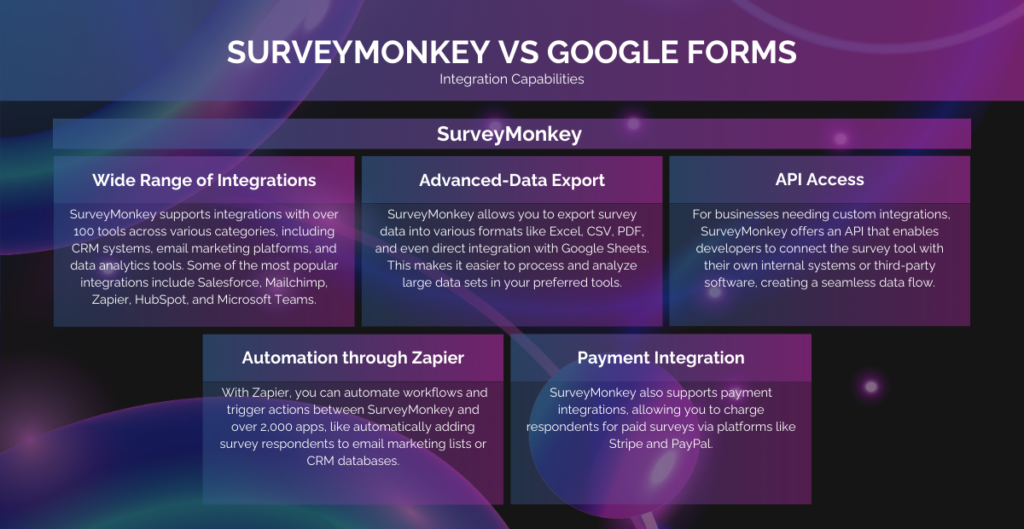
- Wide Range of Integrations: SurveyMonkey supports integrations with over 100 tools across various categories, including CRM systems, email marketing platforms, and data analytics tools. Some of the most popular integrations include Salesforce, Mailchimp, Zapier, HubSpot, and Microsoft Teams.
- Advanced-Data Export: SurveyMonkey allows you to export survey data into various formats like Excel, CSV, PDF, and even direct integration with Google Sheets. This makes it easier to process and analyze large data sets in your preferred tools.
- API Access: For businesses needing custom integrations, SurveyMonkey offers an API that enables developers to connect the survey tool with their own internal systems or third-party software, creating a seamless data flow.
- Automation through Zapier: With Zapier, you can automate workflows and trigger actions between SurveyMonkey and over 2,000 apps, like automatically adding survey respondents to email marketing lists or CRM databases.
- Payment Integration: SurveyMonkey also supports payment integrations, allowing you to charge respondents for paid surveys via platforms like Stripe and PayPal.
Google Forms Integration Capabilities
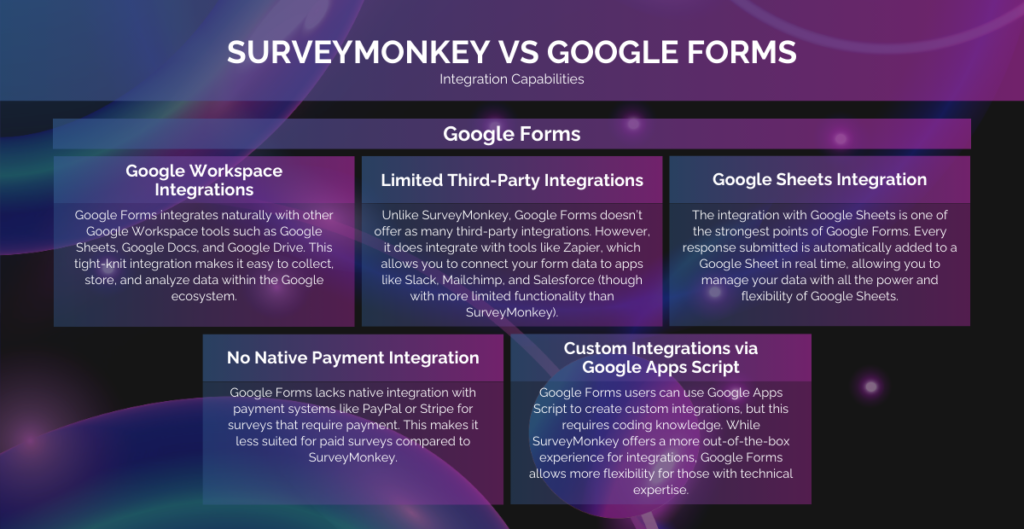
- Google Workspace Integrations: Google Forms integrates naturally with other Google Workspace tools such as Google Sheets, Google Docs, and Google Drive. This tight-knit integration makes it easy to collect, store, and analyze data within the Google ecosystem.
- Limited Third-Party Integrations: Unlike SurveyMonkey, Google Forms doesn’t offer as many third-party integrations. However, it does integrate with tools like Zapier, which allows you to connect your form data to apps like Slack, Mailchimp, and Salesforce (though with more limited functionality than SurveyMonkey).
- Google Sheets Integration: The integration with Google Sheets is one of the strongest points of Google Forms. Every response submitted is automatically added to a Google Sheet in real-time, allowing you to manage your data with all the power and flexibility of Google Sheets.
- No Native Payment Integration: Google Forms lacks native integration with payment systems like PayPal or Stripe for surveys that require payment. This makes it less suited for paid surveys compared to SurveyMonkey.
- Custom Integrations via Google Apps Script: Google Forms users can use Google Apps Script to create custom integrations, but this requires coding knowledge. While SurveyMonkey offers a more out-of-the-box experience for integrations, Google Forms allows more flexibility for those with technical expertise.
Difference Between SurveyMonkey and Google Forms, Integration Capabilities:
| Feature | SurveyMonkey | Google Forms |
| Third-Party Integrations | Over 100 integrations (Salesforce, Zapier, Mailchimp) | Limited integrations (Zapier, Google Workspace) |
| Google Workspace Integrations | Limited (via Zapier) | Seamlessly integrates with Google Sheets, Docs, Drive |
| Custom API | Available for custom integrations | Custom integrations via Google Apps Script |
| Data Export Options | Excel, CSV, PDF, Google Sheets | Google Sheets (real-time), CSV |
| Payment Integration | Stripe, PayPal | None |
| Automation Tools | Extensive with Zapier | Limited via Zapier |
Which Survey Tool Takes the W or L?
- Winner: SurveyMonkey, scoring an 8 out of 10, leads in integration capabilities. With over 100 integrations, advanced API access, and powerful third-party automation tools via Zapier, SurveyMonkey makes it easy to connect to a wide array of business systems and platforms. It’s the best choice for organizations that need a robust, interconnected survey tool.
- Google Forms follows with a 6 out of 10. While it offers excellent Google Workspace integrations and the ability to automate with Zapier, its limited third-party integrations and lack of native payment systems make it less flexible for larger businesses or those requiring more complex integrations.
Disclaimer: This is a simplified comparison based on the provided information. Real-world performance and user experience may vary.
SurveyMonkey vs Google Forms: Mobile Compatibility
In today’s world, mobile compatibility is crucial for survey tools, as many respondents complete surveys on smartphones or tablets. Let’s dive into how SurveyMonkey and Google Forms compare in terms of their mobile experience.
SurveyMonkey Mobile Compatibility
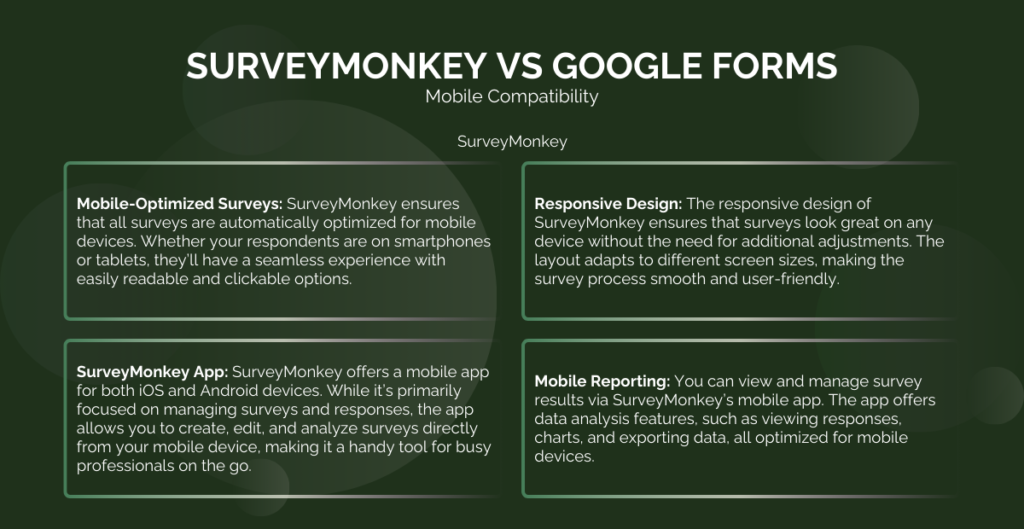
- Mobile-Optimized Surveys: SurveyMonkey ensures that all surveys are automatically optimized for mobile devices. Whether your respondents are on smartphones or tablets, they’ll have a seamless experience with easily readable and clickable options.
- Responsive Design: The responsive design of SurveyMonkey ensures that surveys look great on any device without the need for additional adjustments. The layout adapts to different screen sizes, making the survey process smooth and user-friendly.
- SurveyMonkey App: SurveyMonkey offers a mobile app for both iOS and Android devices. While it’s primarily focused on managing surveys and responses, the app allows you to create, edit, and analyze surveys directly from your mobile device, making it a handy tool for busy professionals on the go.
- Mobile Reporting: You can view and manage survey results via SurveyMonkey’s mobile app. The app offers data analysis features, such as viewing responses, charts, and exporting data, all optimized for mobile devices.
Google Forms Mobile Compatibility
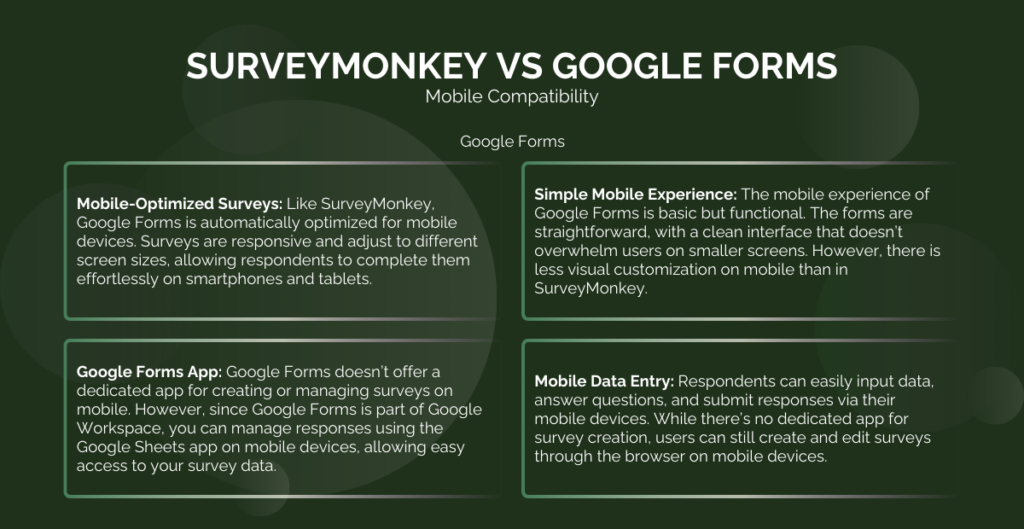
- Mobile-Optimized Surveys: Like SurveyMonkey, Google Forms is automatically optimized for mobile devices. Surveys are responsive and adjust to different screen sizes, allowing respondents to complete them effortlessly on smartphones and tablets.
- Simple Mobile Experience: The mobile experience of Google Forms is basic but functional. The forms are straightforward, with a clean interface that doesn’t overwhelm users on smaller screens. However, there is less visual customization on mobile than in SurveyMonkey.
- Google Forms App: Google Forms doesn’t offer a dedicated app for creating or managing surveys on mobile. However, since Google Forms is part of Google Workspace, you can manage responses using the Google Sheets app on mobile devices, allowing easy access to your survey data.
- Mobile Data Entry: Respondents can easily input data, answer questions, and submit responses via their mobile devices. While there’s no dedicated app for survey creation, users can still create and edit surveys through the browser on mobile devices.
Difference Between SurveyMonkey and Google Forms, Mobile Compatibility:
| Feature | SurveyMonkey | Google Forms |
| Mobile-Optimized Surveys | Automatically optimized for mobile devices | Automatically optimized for mobile devices |
| Mobile App for Survey Creation | Available for iOS and Android | None (can create surveys via mobile browser) |
| Mobile Reporting | View and analyze responses via the mobile app | Google Sheets app for data management |
| Mobile User Experience | Highly responsive, clean design | Simple, straightforward, but limited visuals |
| Mobile Data Entry | Easy and engaging with responsive design | Simple data entry, functional but basic |
Which Survey Tool Takes the W or L?
- Winner: SurveyMonkey, scoring an 8 out of 10, takes the lead in mobile compatibility. With its mobile-optimized surveys, dedicated mobile app for survey management, and responsive design, SurveyMonkey offers a superior mobile experience, making it ideal for users who need to manage and analyze surveys on the go.
- Google Forms follows with a 7 out of 10. While it’s mobile-friendly and provides an adequate mobile survey experience, it lacks a dedicated app for survey creation and editing, limiting its functionality for users who require full mobile access. However, for simple surveys, Google Forms is still a reliable option.
Disclaimer: This is a simplified comparison based on the provided information. Real-world performance and user experience may vary.
SurveyMonkey vs Google Forms: Data Security
Okay, let’s talk about data security when it comes to surveys. It’s a big deal, especially when you’re dealing with sensitive information. You want to make sure your respondents’ data is safe and sound, right? SurveyMonkey and Google Forms both offer features to protect your data, but they have different strengths. Let’s break down how they compare in terms of data protection.
SurveyMonkey Data Security

- Advanced Encryption: SurveyMonkey provides AES 256-bit encryption for data in transit and at rest, ensuring that all survey responses are securely protected. This level of encryption is commonly used for handling sensitive and personal information.
- HIPAA Compliance: For organizations handling healthcare data, SurveyMonkey offers HIPAA-compliant plans, ensuring that the surveys meet regulatory standards for privacy and security in the healthcare sector.
- GDPR Compliance: SurveyMonkey is GDPR-compliant, ensuring that survey data is collected and stored following the General Data Protection Regulation. This is especially important for businesses operating in the EU or dealing with European customer data.
- Two-Factor Authentication (2FA): SurveyMonkey supports two-factor authentication to enhance account security. This extra layer of protection ensures that only authorized users can access sensitive survey data.
- Data Ownership: SurveyMonkey provides clear terms regarding data ownership, ensuring that the user retains ownership of the data they collect. The platform does not sell or share survey data with third parties.
- Enterprise-Level Security Features: SurveyMonkey also offers enterprise-level security features, including single sign-on (SSO) and customizable permission settings for team members, adding an extra layer of control for businesses managing multiple users.
Google Forms Data Security
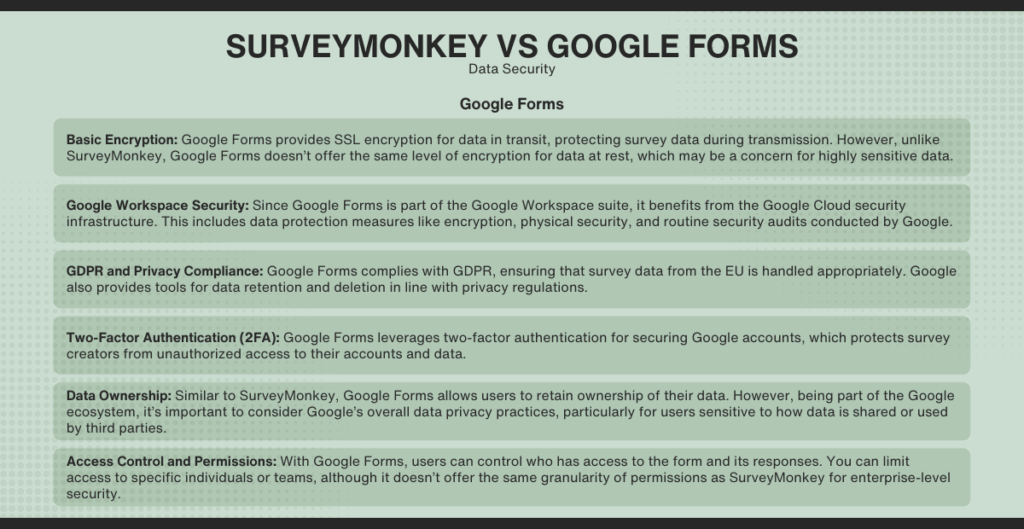
- Basic Encryption: Google Forms provides SSL encryption for data in transit, protecting survey data during transmission. However, unlike SurveyMonkey, Google Forms doesn’t offer the same level of encryption for data at rest, which may be a concern for highly sensitive data.
- Google Workspace Security: Since Google Forms is part of the Google Workspace suite, it benefits from the Google Cloud security infrastructure. This includes data protection measures like encryption, physical security, and routine security audits conducted by Google.
- GDPR and Privacy Compliance: Google Forms complies with GDPR, ensuring that survey data from the EU is handled appropriately. Google also provides tools for data retention and deletion in line with privacy regulations.
- Two-Factor Authentication (2FA): Google Forms leverages two-factor authentication for securing Google accounts, which protects survey creators from unauthorized access to their accounts and data.
- Data Ownership: Similar to SurveyMonkey, Google Forms allows users to retain ownership of their data. However, being part of the Google ecosystem, it’s important to consider Google’s overall data privacy practices, particularly for users sensitive to how data is shared or used by third parties.
- Access Control and Permissions: With Google Forms, users can control who has access to the form and its responses. You can limit access to specific individuals or teams, although it doesn’t offer the same granularity of permissions as SurveyMonkey for enterprise-level security.
Difference Between SurveyMonkey and Google Forms, Data Security:
| Feature | SurveyMonkey | Google Forms |
| Encryption | AES 256-bit encryption (data at rest and in transit) | SSL encryption (data in transit) |
| HIPAA Compliance | Available with premium plans | Not HIPAA-compliant |
| GDPR Compliance | Fully compliant | Fully compliant |
| Two-Factor Authentication (2FA) | Supported | Supported |
| Data Ownership | Users retain ownership of survey data | Users retain ownership, but part of Google’s ecosystem |
| Enterprise-Level Security | Customizable permissions, SSO, and enterprise features | Limited permissions for team access |
| Security Audits | Regular security audits | Regular Google security audits |
Which Survey Tool Takes the W or L?
- Winner: SurveyMonkey, scoring an 8 out of 10, excels in data security. Its robust encryption, HIPAA and GDPR compliance, and enterprise-grade security features, such as two-factor authentication and data ownership guarantees, make it the preferred option for businesses that prioritize the security and privacy of sensitive data.
- Google Forms follows with a 7 out of 10. While it offers adequate security through SSL encryption, GDPR compliance, and Google’s robust infrastructure, it lacks HIPAA compliance and the same advanced data protection features as SurveyMonkey, making it better suited for less sensitive survey data.
Disclaimer: This is a simplified comparison based on the provided information. Real-world performance and user experience may vary.
SurveyMonkey vs Google Forms: Customer Support & Training
You know how frustrating it is when you’re trying to build a survey, and you hit a roadblock? Or worse, something breaks and you’re stuck? That’s where solid customer support and helpful training resources come in. They’re your lifelines, your safety nets, your “gotcha!” moments when things get tricky. So, let’s put SurveyMonkey and Google Forms head-to-head and see which one throws you the better lifeline.
SurveyMonkey Customer Support & Training
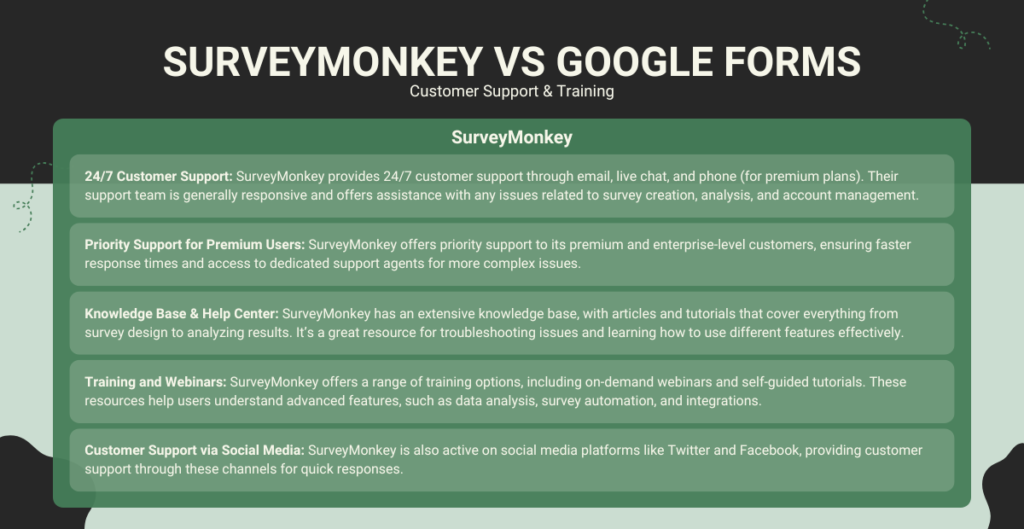
- 24/7 Customer Support: SurveyMonkey provides 24/7 customer support through email, live chat, and phone (for premium plans). Their support team is generally responsive and offers assistance with any issues related to survey creation, analysis, and account management.
- Priority Support for Premium Users: SurveyMonkey offers priority support to its premium and enterprise-level customers, ensuring faster response times and access to dedicated support agents for more complex issues.
- Knowledge Base & Help Center: SurveyMonkey has an extensive knowledge base, with articles and tutorials that cover everything from survey design to analyzing results. It’s a great resource for troubleshooting issues and learning how to use different features effectively.
- Training and Webinars: SurveyMonkey offers a range of training options, including on-demand webinars and self-guided tutorials. These resources help users understand advanced features, such as data analysis, survey automation, and integrations.
- Customer Support via Social Media: SurveyMonkey is also active on social media platforms like Twitter and Facebook, providing customer support through these channels for quick responses.
Google Forms Customer Support & Training
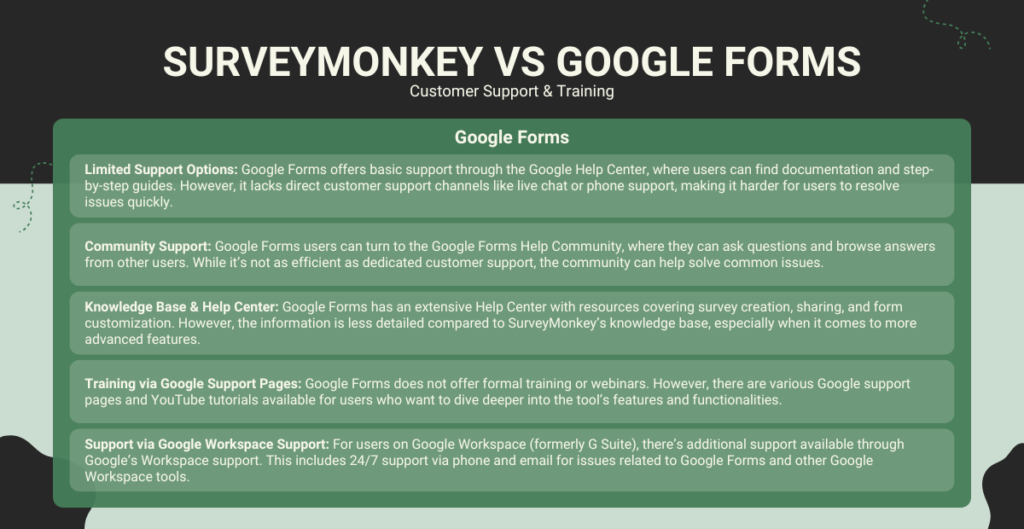
- Limited Support Options: Google Forms offers basic support through the Google Help Center, where users can find documentation and step-by-step guides. However, it lacks direct customer support channels like live chat or phone support, making it harder for users to resolve issues quickly.
- Community Support: Google Forms users can turn to the Google Forms Help Community, where they can ask questions and browse answers from other users. While it’s not as efficient as dedicated customer support, the community can help solve common issues.
- Knowledge Base & Help Center: Google Forms has an extensive Help Center with resources covering survey creation, sharing, and form customization. However, the information is less detailed compared to SurveyMonkey’s knowledge base, especially when it comes to more advanced features.
- Training via Google Support Pages: Google Forms does not offer formal training or webinars. However, there are various Google support pages and YouTube tutorials available for users who want to dive deeper into the tool’s features and functionalities.
- Support via Google Workspace Support: For users on Google Workspace (formerly G Suite), there’s additional support available through Google’s Workspace support. This includes 24/7 support via phone and email for issues related to Google Forms and other Google Workspace tools.
Difference Between SurveyMonkey and Google Forms, Customer Support & Training:
| Feature | SurveyMonkey | Google Forms |
| Customer Support | 24/7 support (email, live chat, phone) | Limited support (Google Help Center, Community) |
| Priority Support | Available for premium plans | Not available |
| Knowledge Base & Help Center | Extensive, with articles and tutorials | Basic documentation, fewer in-depth guides |
| Training Resources | Webinars, on-demand training, tutorials | No formal training, Google support pages |
| Social Media Support | Active on Twitter, Facebook | Not actively offering support via social media |
| Google Workspace Support | Available for enterprise-level users | Available for Google Workspace customers |
Which Survey Tool Takes the W or L?
- Winner: SurveyMonkey, scoring a solid 9 out of 10, takes the lead in customer support and training. With 24/7 customer support, priority assistance for premium users, and a wealth of training resources (including webinars and in-depth tutorials), SurveyMonkey provides an exceptional support experience for users at all levels.
- Google Forms follows with a 6 out of 10. While it offers Google Help Center resources and basic support via Google Workspace, it lacks direct, personalized support and formal training options. This makes it less robust compared to SurveyMonkey for users who require more assistance or advanced learning materials.
Disclaimer: This is a simplified comparison based on the provided information. Real-world performance and user experience may vary.
SurveyMonkey vs Google Forms: Customer Reviews
Customer feedback is an essential aspect of evaluating any product. Let’s take a look at the g2 and Capterra reviews and ratings from actual users of SurveyMonkey and Google Forms, to give you a sense of what people are saying about these platforms.
SurveyMonkey Customers Say…
Strengths
SurveyMonkey is highly rated by users across different review platforms for its ease of use, wide range of features, and ability to handle complex surveys. However, like any tool, it comes with its share of pros and cons.
SurveyMonkey makes it so easy to create surveys that are both professional and easy to distribute. I love the design templates, and it’s user-friendly for both beginners and experienced users.
I really appreciate the flexibility of SurveyMonkey’s tools. From question types to customizable themes, I can create exactly the survey I need for my research.
The analysis tools on SurveyMonkey are top-notch. The ability to easily visualize responses and generate reports is invaluable for understanding customer feedback.
Concerns
While SurveyMonkey is great, it gets a little expensive. The free version has limited features, and to get full access to all the powerful tools, you have to pay for one of the premium plans.
The free plan of SurveyMonkey has some serious limitations, like a limited number of questions per survey and restrictions on response collection. It can feel restrictive if you’re looking for more flexibility.
Google Forms Customers Say…
Strengths
Google Forms is popular due to its simplicity, integration with Google Workspace, and zero cost. However, its lack of advanced features and customization options can be a drawback for users with complex survey needs.
I love how easy it is to create a survey using Google Forms. It’s totally free, and I can create surveys in just a few clicks. It’s perfect for simple feedback collection.
Since I already use Google Workspace for my business, Google Forms integrates perfectly with other tools like Google Sheets, making data analysis a breeze.
For simple surveys, Google Forms is excellent. It’s not fancy, but it gets the job done, and there’s nothing better than having a free, no-frills option.
Concerns
While Google Forms is easy to use, the lack of design options and advanced features is a downside. There are only so many ways to customize the look and feel of the form.
The biggest downside for me is that Google Forms lacks advanced survey logic and features. You can’t do things like question branching, which limits how dynamic the surveys can be.
SurveyMonkey vs Google Forms: Pricing
Alright, let’s talk money! When choosing between SurveyMonkey and Google Forms, you need to figure out what you’re willing to spend. Both platforms have different pricing structures, so it’s important to understand how much each one will cost you. You want to find the platform that gives you the best value for your money, right?
SurveyMonkey Pricing Plans
| Plan | Price | Key Features |
|---|---|---|
| Individual Plans | Starting at $12.22/month |
|
| Team Advantage | $30/user/month (billed annually) |
|
| Team Premier | $75/user/month (billed annually) |
|
| Enterprise | Contact for pricing |
|
Google Forms Pricing Plans
| Plan | Price | Key Features |
|---|---|---|
| Free Version | Free |
|
| Business Starter | $6/user/month |
|
| Business Standard | $12/user/month |
|
| Business Plus | $18/user/month |
|
| Enterprise | Custom pricing |
|
Which Survey Tool Takes the W or L?
- Google Forms, scoring a 9 out of 10, stands out with its completely free access, offering unlimited questions and responses without any cost. This makes it an excellent choice for individuals and small businesses seeking a cost-effective solution.
- SurveyMonkey follows with a 7 out of 10. While it offers advanced features and customization options, these come at a higher price point, which may be a consideration for users with budget constraints.
SurveyMonkey vs Google Forms: Which One is Best for Your Needs?
When selecting a survey tool, it’s crucial to align your choice with your specific requirements, budget, and desired features. Both SurveyMonkey and Google Forms offer distinct advantages. Here’s a detailed comparison to help you make an informed decision.
Who Should Choose Google Forms?
Google Forms is ideal for users seeking a straightforward, cost-effective solution for basic surveys and data collection. It’s particularly beneficial for those already utilizing the Google Workspace suite.
Key Benefits:
- Cost-Effective: Google Forms is entirely free, offering unlimited surveys and responses without any hidden fees.
- Ease of Use: With its intuitive interface, users can quickly create and distribute surveys without a steep learning curve.
- Integration with Google Workspace: Seamless integration with tools like Google Sheets and Google Drive facilitates efficient data management and analysis.
Ideal For:
- Small Businesses and Individuals: Those needing a simple tool for basic surveys, feedback collection, or event registrations.
- Educators and Non-Profits: Organizations seeking a free, easy-to-use platform for quizzes, evaluations, or volunteer sign-ups.
- Personal Projects: Individuals conducting informal surveys or gathering opinions without the need for advanced features.
Who Should Choose SurveyMonkey?
SurveyMonkey caters to users requiring advanced survey capabilities, detailed analytics, and extensive customization options. It’s well-suited for professional and enterprise-level needs.
Key Benefits:
- Advanced Features: Offers a wide range of question types, survey logic, and customization options to create tailored surveys.
- Robust Analytics: Provides in-depth data analysis tools, including cross-tabulation and trend analysis, to derive actionable insights.
- Enterprise Solutions: Designed to handle large-scale surveys with features like team collaboration, enhanced security, and dedicated support.
Ideal For:
- Businesses and Marketers: Conducting market research, customer satisfaction surveys, or employee feedback with complex requirements.
- Researchers: Needing advanced survey tools for academic studies, clinical trials, or detailed data collection.
- Large Organizations: Requiring enterprise-level features, including team collaboration, advanced security, and dedicated support.
SurveyMonkey vs Google Forms: Conclusion
We’ve gone through the ins and outs of both SurveyMonkey and Google Forms. Now, it’s time to see who takes the crown! Both platforms offer solid options, but let’s break it down in a way that makes sense for your specific needs.
- Google Forms is a great option for anyone who needs a simple, free tool for collecting feedback, conducting basic surveys, or managing personal projects. It’s intuitive, cost-effective, and works seamlessly if you’re already using Google Workspace. Need a no-fuss survey tool? Google Forms has your back.
- On the other hand, SurveyMonkey takes things up a notch with its advanced features, powerful analytics, and customization options. If you’re looking for detailed insights, and advanced survey logic, or need to scale up your surveys for business or research, SurveyMonkey’s premium features will give you everything you need.
If you’re in search of the perfect survey tool, here’s the truth: Google Forms is perfect for those seeking simplicity and zero cost, while SurveyMonkey is your best bet if you want an in-depth, professional-grade survey experience.
But what if you want the best of both worlds? SurveySlack.com is an Online survey creator—the perfect mix of powerful survey features without the hefty price tag. It’s user-friendly, effective, and offers just enough features to elevate your surveys without overwhelming you.
Intrigued? Let’s explore:
Google Forms vs SurveyMonkey Alternative >>>
In the end, your choice comes down to your needs. Whether it’s a basic feedback form or a comprehensive survey for your business, the right tool can make all the difference. So, which one will you choose? Comment down below.
Happy surveying!
FAQs About SurveyMonkey vs Google Forms
1. Is Google Forms better than SurveyMonkey?
Google Forms is a free, user-friendly tool suitable for basic surveys and data collection. However, SurveyMonkey offers advanced features, customization options, and robust analytics, making it more suitable for complex surveys and professional use.
2. What are the disadvantages of SurveyMonkey?
While SurveyMonkey provides advanced features, its free plan is limited, and full access requires a paid subscription. Additionally, some users find its customization options less flexible compared to other platforms.
3. Is SurveyMonkey no longer free?
SurveyMonkey offers a free plan with basic features. However, to access advanced functionalities, higher response limits, and enhanced customization, a paid subscription is necessary.
4. Which form builder is better than Google Forms?
Platforms like Jotform offer more advanced features, customization options, and integrations compared to Google Forms. Jotform provides a more intuitive and flexible way to build forms and manage data.
5. Does SurveyMonkey cost money?
Yes, SurveyMonkey offers both free and paid plans. The free plan has limitations, and to access advanced features, higher re
6. Is Google Forms still free?
Yes, Google Forms remains free to use, offering basic features suitable for simple surveys and data collection. However, it lacks some advanced functionalities found in other survey tools.
7. Does Google have a free survey tool?
Yes, Google Forms is a free survey tool that allows users to create and distribute surveys easily. It’s integrated with Google Workspace, making it convenient for users within that ecosystem.
8. What is the daily limit for Google Forms?
Google Forms does not have a specific daily limit for responses. However, Google Workspace accounts have overall storage limits, and extremely high response volumes may be subject to these limits.
9. How does SurveyMonkey work?
SurveyMonkey allows users to create surveys using customizable templates or from scratch. Users can design questions, distribute surveys via various channels, and analyze responses using built-in analytics tools.
10. Why choose SurveyMonkey?
SurveyMonkey is ideal for users seeking advanced survey features, robust analytics, and extensive customization options. It’s suitable for businesses, researchers, and professionals who require detailed insights and a comprehensive survey platform.
